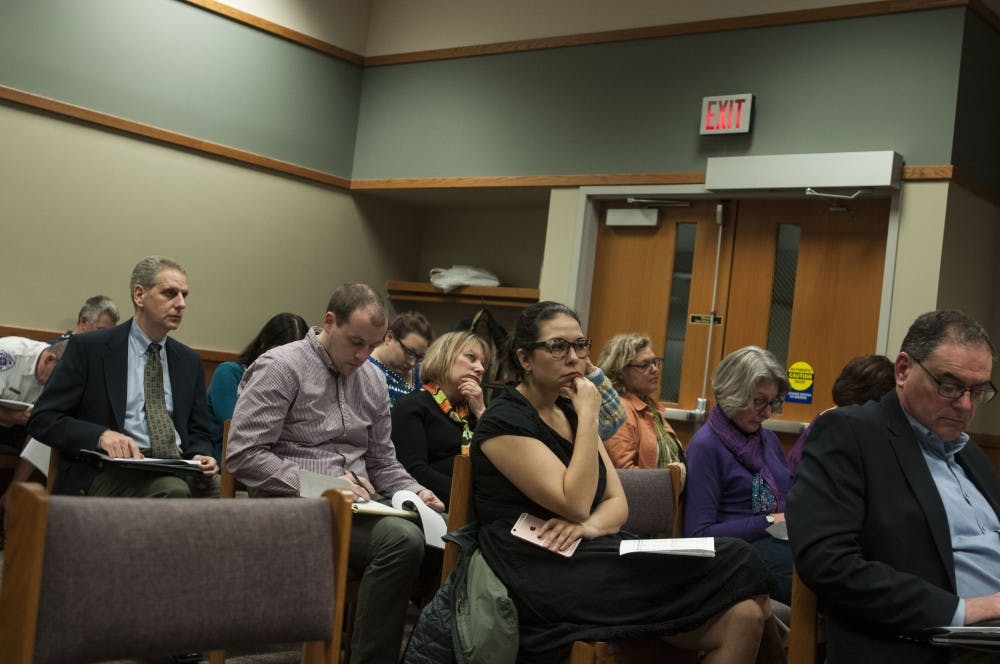The city of East Lansing is continuing to make progress on plans to slim down Harrison Road from four to three lanes between Grand River and Michigan Avenues.
Being put on a "road diet," as it has been dubbed, would abandon the current two-lane setup in each direction in favor of one lane each with a center turn lane.
Dedicated bike lanes could also be added, connecting the bike lanes found on Michigan and Grand River Avenues.
John Boyce, a 35-year resident of Harrison Road just north of the proposed changes, regularly walks, bikes and drives along the corridor and welcomes the additional bike lanes being proposed.
Boyce said it would improve safety for both pedestrians, who would not have to share Harrison Road's skinny sidewalks with bike traffic, and bicyclists, who would have clearly-marked lanes for cars to avoid.
"This has been a long time coming to see bike lanes through there," Boyce said.
The plans could be paid for by a federal Transportation Alternatives grant or Michigan Department of Transportation safety program funding, Director of Public Works Scott House said.
Mayor Mark Meadows said he was personally "very much supportive" of the road diet because it would increase safety along the corridor. This was echoed by Thomas Baumann, chair of the city's Transportation Commission.
"The conversion to a three-lane setup is actually a safety conversion that has huge benefits and has been proven to reduce crash rates," Baumann said.
A conversion to three lanes can reduce total crashes by anywhere from 19 to 47 percent, according to the Federal Highway Administration.
A road diet study performed by Lansing architectural consulting firm DLZ noted that a section of Abbot Road saw a 40 percent reduction in crashes after undergoing a similar conversion.
One safety measure is unlikely to happen as a result of the improvements, however.
The stretch of road, as noted previously, is characterized by skinny sidewalks. Yet they will likely not be widened as a part of this project, given the slim right-of-ways available to the city from property owners, House said.
Public comment on the matter at the April 10 council meeting was overwhelmingly positive, but Meadows said he had heard some negativity as well. He said similar skepticism surrounded past road diet projects on Abbot Road and Burcham Drive.
"I don't want the fact that we had three people speak in favor of it to not indicate that we received a number of emails also with concern about what is being proposed here," Meadows said.
Residents have voiced concerns that slimming the road down would cause more traffic backups both on Harrison and on adjacent streets, as drivers could potentially seek shortcuts to avoid driving on the skinnier road.
However, the road diet study found it was unlikely the switch would force more traffic into the surrounding neighborhoods. It also found that traffic volumes at Harrison's intersections with Michigan and Grand River have decreased by more than 20 percent in the last decade.
Baumann, in a letter to city council, feared a move to slim down a busy road could sound like a bad idea to residents unfamiliar with the details. He urged officials to inform residents of the plan's benefits.
"The public impression of these measures might not be so positive," Baumann said in the letter. "It is important that the discussion of the conversion be fact-based and that the conclusions of the study be clearly presented."
Support student media!
Please consider donating to The State News and help fund the future of journalism.
Discussion
Share and discuss “Harrison 'road diet' moving forward; to increase safety, add bike lanes” on social media.







